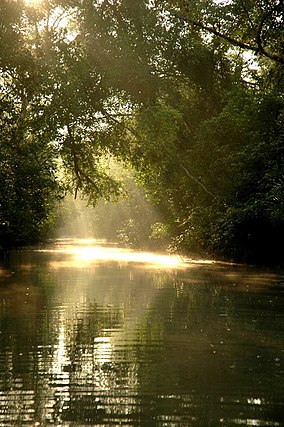The Sundarbans is a natural region comprising southern Bangladesh and a small part in Eastern India. It is the largest single block of tidal halophytic mangrove forest in the world. The Sundarbans covers approximately 10,000 square kilometres (3,900 sq mi) most of which is in Bangladesh with the remainder in India. The Sundarbans is a UNESCO World Heritage Site.

Sundarbans South, East and West are three protected forests in Bangladesh. This region is densely covered by mangrove forests, and is the largest reserves for the Bengal tiger. The Sundarbans National Park is a National Park, Tiger Reserve, and a Biosphere Reserve located in the Sundarbans delta in the Indian state of West Bengal.A total 245 genera and 334 plant species were recorded by David Prain in 1903.While most of the mangroves in other parts of the world are characterised by members of the Rhizophoraceae, Avicenneaceae or Combretaceae, the mangroves of Bangladesh are dominated by the Malvaceae and Euphorbiaceae.Dominant flora includes:
The Sundarbans flora is characterised by the abundance of sundari (Heritiera fomes), gewa (Excoecaria agallocha), goran (Ceriops decandra) and keora (Sonneratia apetala) all of which occur prominently throughout the area. The characteristic tree of the forest is the sundari (Heritiera littoralis), from which the name of the forest had probably been derived. It yields a hard wood, used for building houses and making boats, furniture and other things. New forest accretions is often conspicuously dominated by keora (Sonneratia apetala) and tidal forests. It is an indicator species for newly accreted mudbanks and is an important species for wildlife, especially spotted deer (Axis axis). There is abundance of dhundul or passur (Xylocarpus granatum) and kankra (Bruguiera gymnorrhiza) though distribution is discontinuous. Among palms, Poresia coaractata, Myriostachya wightiana and golpata (Nypa fruticans), and among grasses spear grass (Imperata cylindrica) and khagra (Phragmites karka) are well distributed.

The varieties of the forests that exist in Sundarbans include mangrove scrub, littoral forest, saltwater mixed forest, brackish water mixed forest and swamp forest. Besides the forest, there are extensive areas of brackish water and freshwater marshes, intertidal mudflats, sandflats, sand dunes with typical dune vegetation, open grassland on sandy soils and raised areas supporting a variety of terrestrial shrubs and trees. Since Prain's report there have been considerable changes in the status of various mangrove species and taxonomic revision of the man-grove flora. However, very little exploration of the botanical nature of the Sundarbans has been made to keep up with these changes. Differences in vegetation have been explained in terms of freshwater and low salinity influences in the Northeast and variations in drainage and siltation. The Sundarbans has been classified as a moist tropical forest demonstrating a whole mosaic of seres, comprising primary colonisation on new accretions to more mature beach forests. Historically vegetation types have been recognised in broad correlation with varying degrees of water salinity, freshwater flushing and physiography.

The Sundarbans provides a unique ecosystem and a rich wildlife habitat. According to the 2015 tiger census, the Sundarbans have about 170 tigers (106 in Bangladesh and 64 in India). Although previous rough estimates had suggested much higher figures close to 300, the 2011 census provided the first ever scientific estimate of tigers from the area Tiger attacks are frequent in the Sundarbans. Between 0 and 50 people are killed each year.
There is much more wildlife here than just the endangered Royal Bengal tiger (Panthera tigris tigris). Most importantly, mangroves are a transition from the marine to freshwater and terrestrial systems, and provide critical habitat for numerous species of small fish, crabs, shrimps and other crustaceans that adapt to feed and shelter, and reproduce among the tangled mass of roots, known as pneumatophores, which grow upward from the anaerobic mud to get the supply of oxygen. Fishing cats, macaques, wild boars, common grey mongooses, foxes, jungle cats, flying foxes, pangolins, and spotted deer are also found in abundance in the Sundarbans.
A 1991 study has revealed that the Bangladeshi part of the Sundarbans supports diverse biological resources including at least 150 species of commercially important fish, 270 species of birds, 42 species of mammals, 35 reptiles and 8 amphibian species. This represents a significant proportion of the species present in Bangladesh (i.e. about 30% of the reptiles, 37% the birds and 34% of the mammals) and includes a large number of species which are now extinct elsewhere in the country. Two amphibians, 14 reptiles, 25 aves and five mammals are endangered.The Sundarbans is an important wintering area for migrant water birds and is an area suitable for watching and studying avifauna.
The management of wildlife is restricted to, firstly, the protection of fauna from poaching, and, secondly, designation of some areas as wildlife sanctuaries where no extraction of forest produce is allowed and where the wildlife face few disturbances. Although the fauna of Bangladesh have diminished in recent times and the Sundarbans has not been spared from this decline, the mangrove forest retains several good wildlife habitats and their associated fauna. Of these, the tiger and dolphin are target species for planning wildlife management and tourism development. There are high profile and vulnerable mammals living in two contrasting environments, and their statuses and management are strong indicators of the general condition and management of wildlife. Some of the species are protected by legislation, notably by the Bangladesh Wildlife (Preservation) Order, 1973 (P.O. 23 of 1973).
No comments:
Post a Comment